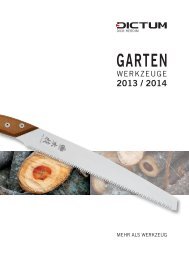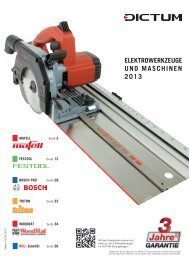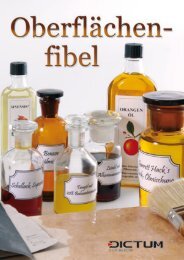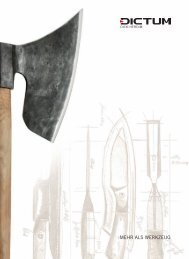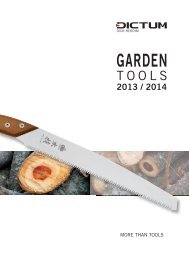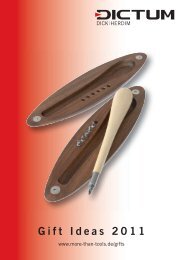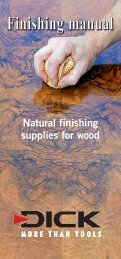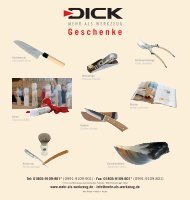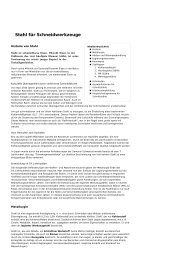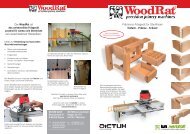Download latest Tool Catalogue as PDF - DICTUM GmbH
Download latest Tool Catalogue as PDF - DICTUM GmbH
Download latest Tool Catalogue as PDF - DICTUM GmbH
You also want an ePaper? Increase the reach of your titles
YUMPU automatically turns print PDFs into web optimized ePapers that Google loves.
Knife KitsaBa IC CUT ® OUTDOOR KNIFE KITCompose your own individual outdoorknife with high quality components fromIC Cut: 3.5 mm thick blade of rustproofAUS6-Stahl, hardened and annealed,flat-ground sides, hollow-ground cuttingedge, laminated cocobolo handle scales,studs, sturdy belt-mounting leathersheath, with <strong>as</strong>sembly instructions.Blade length 110 mmBlade thickness 3.5 mmOverall length 235 mmWeight 240 gno. 709039 56.97 € 67.80 €B KIT FOR A NORDIC STYLE KNIFEIncludes all the materials requiredfor making your own highly individualNordic knife. Hardened, pre-sharpenedUddeholm No. 1770 carbon steel blade,m<strong>as</strong>ur birch, reindeer horn slice, br<strong>as</strong>shead plate, leather, thread, with brief<strong>as</strong>sembly instructions.Blade length 95 mmBlade thickness 2.5 mmOverall length 205 mmno. 709062 37.39 € 44.50 €Obsidiancc OBSIDIAN KNIFE BY SUEMORIUnique pieces:The Hokkaido-b<strong>as</strong>ed knife-maker Tok<strong>as</strong>hiSuemori learned the archaic art offracturing obsidian from the Ainu, anancient tribe in the north of Japan. Weare occ<strong>as</strong>ionally able to offer examplesof his work, with each piece having aunique form. The price lies between280-490 € depending on the size andform of the knife.no. 716247price on requestFor more information and Obsidian products <strong>as</strong> well <strong>as</strong> toolsfor processing Obsidian see www.more-than-tools.de/obsidianBrief glossary of steel termsWhite paper Steel (Shiro gami):Trade name for a highly pure carbonsteel made by the Hitachi Company,mainly used for making cutting tools.This steel is particularly hard and h<strong>as</strong>an especially fine martensitic structure.This means you can grind it to exceptionalsharpness, which retains for a longtime. Not rust-proof.(C = 1.2%, Mn = 0.2%, Si = 0.2%,S < 0.04%, P < 0.02%)Blue paper Steel (ao gami):Similar to White Paper Steel but alloyedwith additional 0.4% chromium and1.5% tungsten. This makes it somewhattougher.vg-10 steel:Rustproof high-cl<strong>as</strong>s blade steel, madein Takefu. Its content of cobalt andcarbides make it extremely durable.(C = 1%, Cr = 15%, Co = 1.5%, Mn =0.5 %, Mo = 1.0%, P = 0.03%,Si =0.6 %, V = 0.2%)Sg-2:Rustproof heavy duty steel madeusing the powder metallurgy process.(C = 1.3%, Cr = 15%, Mo = 3%,V = 2%)SKd-11:High-alloyed Japanese tool steel, whichw<strong>as</strong> originally developed for the use ofmachine tools. Due to its high percentageof carbide it is very durable, abr<strong>as</strong>ionand corrosion resistant.(C = 1.6%, Cr = 13%, Mo = 1%,V = 0.4%)d2:Is characterized by excellent wearresistance and sharpness. This steelfeatures a chrome content of 12% andis therefore designated <strong>as</strong> a so calledrust-resistant steel.(C = 1.5%, Cr = 12%, Mo = 0.8%,V = 0.9%, Si = 0.6%, Mn = 0.6%)atS34:A very pure, rustproof carbon steelmade in Japan that displays a very finecrystalline structure due to its highmolybdenum content.(C = 1%, Cr = 14%, Mo = 4%,Mn = 0.4%, Si = 0.35%, P = 0.03%,S = 0.02%)440c:Hardenable rustproof steel originally developedfor making ball bearings. Highwear- and corrosion resistance.(C = 1%, Cr = 17%, Mn = 1%,Mo = 0.75%, Si = 1%, S = 0.03%,P = 0.04%)gin 1:Rustproof blade steel made by Hitachi.Particularly corrosion- and wear-resistantdue to its high chromium content (chromiumcarbides).(C = 0.9%, Cr = 15.5%, Mn = 0.6%,Mo = 0.3%, Si = 0.35%, S = < 0.03%,P < 0.02%)carbon steel:A non-alloyed tool steel with a carboncontent of 0.2 - 1.7% which can besharpened to a very high degree dueto its fine grain structure.pM steel:Sintering allows metals which normallycannot be alloyed or welded togetherto be combined. The components aremixed in powdered form and then hotisostatically pressed in a process known<strong>as</strong> Powder Metallurgy (PM). These rustproofsteels even outreach low alloyedsteels in terms of hardness. However,they cannot be grinded <strong>as</strong> fine <strong>as</strong> lowalloyed carbon steels (e.g. White PaperSteel).tamahagane:Japanese sword steel produced fromiron sand (M<strong>as</strong>a) smelted in a charcoalfired furnace. This process, called„Tatara“, is the earliest known method(approx. 1800 years old) in which steelcan be obtained directly from the rawmaterial without any intermediate steps.Known <strong>as</strong> steel with the highest possibledegree of purity.dam<strong>as</strong>cus steel:Named after Dam<strong>as</strong>cus, the ancientcentre of the metalworking trade, thissteel is well known for its highly grainedsurface. First produced in India around300 BC. The unique structure w<strong>as</strong>originally created using steel segregationtechniques during cooling (known<strong>as</strong> Wootz steel). In modern Dam<strong>as</strong>cussteels, this structure is created by forgewelding and folding steels of differentcarbon contents together.Suminag<strong>as</strong>hi steel:Japanese variation of Dam<strong>as</strong>cus steelwhich in contr<strong>as</strong>t to European Dam<strong>as</strong>cusblades contains a carbon steel core.This Japanese Dam<strong>as</strong>cus is often calledSuminag<strong>as</strong>hi (ink drawing) steel <strong>as</strong> thepattern is reminding of an ink painting.hSS (high Speed Steel):A type of steel which is heat resistant toapprox. 570 °C due to a relatively highcontent of chromium, molybdenum,tungsten and vanadium. Mainly usedwith machine and turning tool blades.tool steel:Alloyed or non-alloyed steel with acarbon content of at le<strong>as</strong>t 0.2%, a levelwhich allows the steel to be hardened.alloying:The addition of certain metals (e.g.chromium, manganese) to change thecharacteristics of the b<strong>as</strong>e metal.hardening:Heating hardenable steel to above thetransformation point (approx. 780 °Cfor carbon steels, approx. 1050 °C forrustproof steels, depending on the alloy)and subsequently quenching them (inwater, oil or air) results in the formationof a new, finer crystalline structure.The steel gets harder, more brittle andmore sharpenable because of the finerstructure. The hardness can be testedusing the Rockwell method (pressing adiamond cone into the surface of thesteel).annealing:After hardening, the steel must be annealedto avoid brittleness. In general, thesteel is heated in a controlled manner(for a specific time at between 180 and300 °C) to remove the internal stressesin the structure. In the process, thesteel becomes somewhat less hard, butgets tougher and less prone to chipping.It is important to note that the propertiesexhibited by an individual bladedo not solely depend on the chemicalcomposition of the steel used. Theblacksmith‘s skill and the nature of thehardening process employed also play avery important role in the quality of theoutcome. Careful forging, for example,further refines and homogenises thesteel‘s structure. Prolonged heating duringthe forging, hardening or annealingprocess lead to carbon diffusion thatdiminishes the hardness and edge lifeof the blade. Impurities (e.g. P, S) havea very detrimental effect on the bladeand cause a dramatic incre<strong>as</strong>e in thebrittleness of the edge.284




